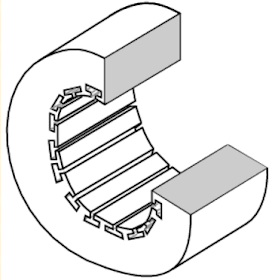Most AC motors are induction motors. Induction motors are favored due to their ruggedness and simplicity. In fact, 90% of industrial motors are induction motors. Nikola Tesla conceived the basic principals of the poly-phase induction motor in 1883 and had a 400 W model by 1888.
Most large (> 1 kW) industrial motors are poly-phase induction motors. By "polyphase", we mean that the stator contains multiple distinct windings per motor pole, driven by corresponding time shifted sine waves. In practice, this is 2 or 3 phases. Large industrial motors are 3-phase. While we include numerous illustrations of 2-phase motors for simplicity, we must emphasize that nearly all poly-phase motors are 3-phase. By "induction motor", we mean that the stator windings induce a current flow in the rotor conductors like a transformer (and unlike a brushed DC commutator motor).
Construction
An induction motor is composed of a rotor (known as an armature) and a stator containing windings connected to a poly-phase energy source as shown on Picture 1 below. The simple 2-phase induction motor below is similar to the 1/2 horsepower motor which Nikola Tesla introduced in 1888.
Picture 1: Tesla poly-phase induction motor
The stator on Picture 1 above is wound with pairs of coils corresponding to the phases of electrical energy available. The 2-phase induction motor stator above has 2-pairs of coils -- one pair for each of the two phases of AC. The individual coils of a pair are connected in series and correspond to the opposite poles of an electromagnet. That is, one coil corresponds to an N-pole and the other to a S-pole until the phase of AC changes polarity. The other pair of coils is oriented 90 degrees in space to the first pair. This pair of coils is connected to AC shifted in time by 90 degrees in the case of a 2-phase motor. In Tesla's time, the source of the 2 phases of AC was a 2-phase alternator.
The stator on Picture 1 above has salient, obvious protruding poles as used on Tesla's early induction motor. This design is used to this day for sub-fractional horsepower motors (i.e., lower than 50 watts). However, for larger motors less torque pulsation and higher efficiency results if the coils are embedded into slots cut into the stator laminations. (Picture 2 below)
Picture 2: Stator frame showing slots for windings
The stator laminations are thin insulated rings with slots punched from sheets of electrical-grade steel. A stack of these is secured by end screws, which may also hold the end housings.
Picture 3: Stator with (a): 2-φ and (b): 3-φ windings
On Picture 3 above, the windings for both a 2-phase motor and a 3-phase motor have been installed in the stator slots. The coils are wound on an external fixture and then worked into the slots. Insulation wedged between the coil periphery and the slot protects against abrasion. Actual stator windings are more complex than the single windings per pole on Picture 3 above.
Comparing the 2-φ motor to Tesla's 2-φ motor with salient poles, the number of coils is the same. In actual large motors, a pole winding, is divided into identical coils inserted into many smaller slots than above. This group is called a phase belt. See Picture 4 below.
Picture 4: 3-φ distributed windings (left) and Single phase belt (right)
The distributed coils of the phase belt cancel some of the odd harmonics, producing a more sinusoidal magnetic field distribution across the pole. The slots at the edge of the pole may have fewer turns than the other slots. Edge slots may contain windings from two phases. That is, the phase belts overlap.
The key to the popularity of the AC induction motor is simplicity as evidenced by the simple rotor (see Picture 5 below). The rotor consists of a shaft, a steel laminated rotor, and an embedded copper or aluminum squirrel cage shown at (b) removed from the rotor. As compared to a DC motor armature, there is no commutator. This eliminates the brushes, arcing, sparking, graphite dust, brush adjustment and replacement, and re-machining of the commutator.
Picture 5: Laminated rotor (a): embedded squirrel cage ; (b): Conductive cage removed from rotor
The squirrel cage conductors may be skewed, twisted, with respect to the shaft. The misalignment with the stator slots reduces torque pulsations. Both rotor and stator cores are composed of a stack of insulated laminations. The laminations are coated with insulating oxide or varnish to minimize eddy current losses.The alloy used in the laminations is selected for low hysteresis losses.





No comments:
Post a Comment